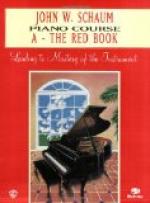“When a new pupil comes who is just starting, or has been badly taught, she must of course begin with hand formation. She learns to form the arch of the hand and secure firm finger joints, especially the nail joint. I form the hand away from the piano, at a table. Nothing can be done toward playing till these things are accomplished. I often have pupils who have been playing difficult music for years, and who consider themselves far advanced. When I show them some of these simple things, they consider them far too easy until they find they cannot do them. Sometimes nothing can be done with such pupils until they are willing to get right down to rock bottom, and learn how to form the hand. As to the length of time required, it depends on the mentality of the pupil and the kind of hand. Some hands are naturally very soft and flabby, and of course it is more difficult to render them strong.
FINGER ACTION
“When the arch of the hand is formed, we cultivate intelligent movement in the finger tips, and for this we must have a strong, dependable nail joint. Of course young students must have knuckle action of the fingers, but I disapprove of fingers being raised too high. As we advance, and the nail joint becomes firmer and more controlled, there is not so great need for much finger action. Velocity is acquired by less and less action of the fingers; force is gained by allowing arm weight to rest on the fingers; lightness and delicacy by taking the arm weight off the fingers—holding it back.
“I use no instruction books for technical drill, but give my own exercises, or select them from various sources. Certain principles must govern the daily practise, from the first. When they are mastered in simple forms later work is only development. Loose wrist exercises, in octaves, sixths, or other forms, should form a part of the daily routine. So should scale playing, for I am a firm believer in scales of all kinds. Chords are an important item of practise. How few students, uninstructed in their principles, ever play good chords? They either flap the hand down from the wrist, with a weak, thin tone, or else they play with stiff, high wrists and arms, making a hard, harsh tone. In neither case do they use any arm weight. It often takes some time to make them see the principles of arm weight and finger grasp.
QUESTIONS OF PEDALING
“Another point which does not receive the attention it deserves is pedaling. Few students have a true idea of the technic of the foot on the pedal. They seem to know only one way to use the damper pedal, and that is to come down hard on it, perhaps giving it a thump at the same time. I give special preparatory exercises for pedal use. Placing the heel on the floor, and the forepart of the foot on the pedal, they learn to make one depression with every stroke




